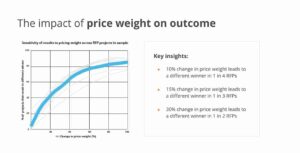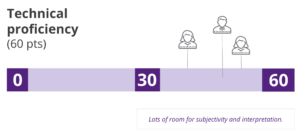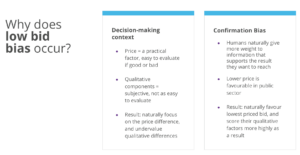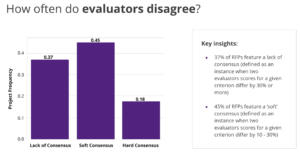An RFP evaluation process goes beyond simple bids and price-only decisions and requires assessing both qualitative and quantitative RFP evaluation criteria. For many public sector organizations, this is where the largest spending decisions are made. The impact of these decisions can leave a ripple effect that’s felt for years, which is why creating structured, balanced RFP evaluation criteria is vital.
Here are 4 common pitfalls buying organizations make during the RFP evaluation process and how you can avoid them when making your RFP evaluation criteria in order to achieve the best possible outcomes.
Mistake 1: Weighting the price too high in evaluation criteria
Weighting price high in your RFP evaluation criteria is often seen as being “price conscious,” but it can skew the outcomes that you are trying to achieve. Organizations that value price too highly during RFP scoring run the risk of buying goods or services that are inexpensive, but that also under-deliver.
According to data insights found in this State of the RFP report, a 15% increase in price will change the outcome of one in three RFPs

Best practices indicate that weighting price at 20-30% in your scoring process is ideal. Before you begin a project, determine what criteria will truly make the difference between success and failure and assign weight accordingly. If you are getting pressured by the business unit influencing the project, show them how increasing the price weighting would impact the outcome so that they understand the implications.
Mistake 2: Having unclear evaluation scales and scoring expectations
Some teams don’t use a structured scale for their RFP scoring system and allow evaluators to assign their own point value to each component, leading to confusion and too much variation in scores. Others use a three-point scale, which doesn’t offer enough variation in score and makes it difficult to make a significant distinction between proposals.

A detailed scale for your evaluation criteria helps evaluators make better distinctions between evaluations. We suggest using a five to ten point scale. By clearly establishing scoring guidelines, you’ll enable consistency and alignment across your internal stakeholders when running an evaluation.
Mistake 3: Separating price scales from other RFP criteria
There is a phenomenon called ‘the lower bid bias’ during an RFP evaluation. When evaluators are made aware of price when evaluating qualitative factors, a systematic bias occurs toward the lowest bidder. This was proven conclusively during a study conducted by the Hebrew University of Jerusalem. Favoring the lowest bid regardless of qualitative factors could have similar negative outcomes as weighting price too highly in an evaluation.

To eliminate bias, the study recommended a two-stage process where price is revealed to the same group of evaluators as qualitative factors, but only after they have evaluated the non-price components of a bid. Alternatively, you could have a different evaluation group for pricing than you do for qualitative factors.
Mistake 4: Not making decisions by consensus
Many teams attempt to simplify their process by averaging their evaluator’s scores. However, if one evaluator gives a score of 2 out of 5, and another a 5, then the average score of a 3.33 isn’t a truly representative conclusion. It could suggest that there was a misunderstanding either in the proposal or the scoring criteria, or even a scoring bias that could impact the final decision.
37% of RFPs feature a lack of consensus, indicating this is a commonly occurring issue among evaluators.

When there is a significant variance in scores teams should hold consensus meetings to understand the discrepancy and come to an agreement. It can be useful to complete all comments and scoring beforehand so that the facilitator is able to focus the conversation on the areas of disagreement. A well-run meeting can get evaluators to a place of understanding and help outliers come to an agreed-upon decision.
How technology can help procurement teams better score vendor proposals
Using technology to conduct your sourcing events is more efficient than trying to evaluate using email, Excel, and paper. This gives your team more time and focus to run effective evaluations with clear evaluation criteria and ultimately achieve better outcomes.
Do you want to uncover how Euna Procurement can help you run seamless evaluations? Request a demo today to learn more.
